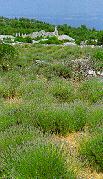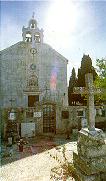



The village of Brusje is situated only 6 kilometres from Hvar. The settlement was a group of shepherd's huts in the 16th century. A series of rural houses run along the road, forming a very picturesque architectural grouping. At first it was a suburb dependent on the town of Hvar. From the beginning of the 18th century it had its own church Sv. Juraj (St. George) which has a statue of the saint on the facade. On the high altar there is a painting of St. Anthony by B. Zelotti (1532-1592), which was transferred here from the Dominican monastery in Hvar.
The former inhabitants were mostly involved with cattle-breeding and agriculture, while today priority is given mostly to the cultivation and processing of lavender, which plays an important role in the island's exports.
On the way into the village, and also on the road from Brusje to Stari Grad, there are two ruins of the summer villas of Njivice and Moncirovo from the 16th century. Descending to the north coast of the island, several coves belonging to the island can be reached. After Vira, there is Jagodna, a very wooded cove, then Kosmaca, Carnica, Lozna, Tatinja and finally Grabovac. In the following cove of Lucisce, there are the remains of a villa with a preserved chapel of the noble Bertucevic. A humanist and a poet, Jerolim, and his son Hortenzije, came from this family (16th century). In the bay of Gradisce there is a prehistoric fortification from the second millennium BC. Illyrian and ancient ceramics have been found here. After Gradisce, there are the coves of Radocinol, Konopljikova and Maslinica, with the country houses of the nobles of Hvar and the families of maritime tradition.